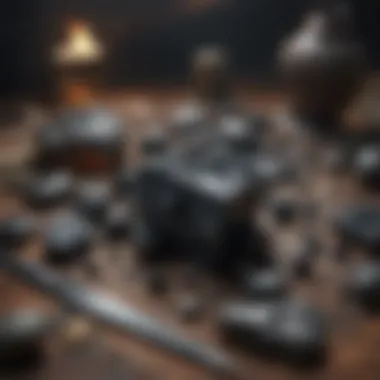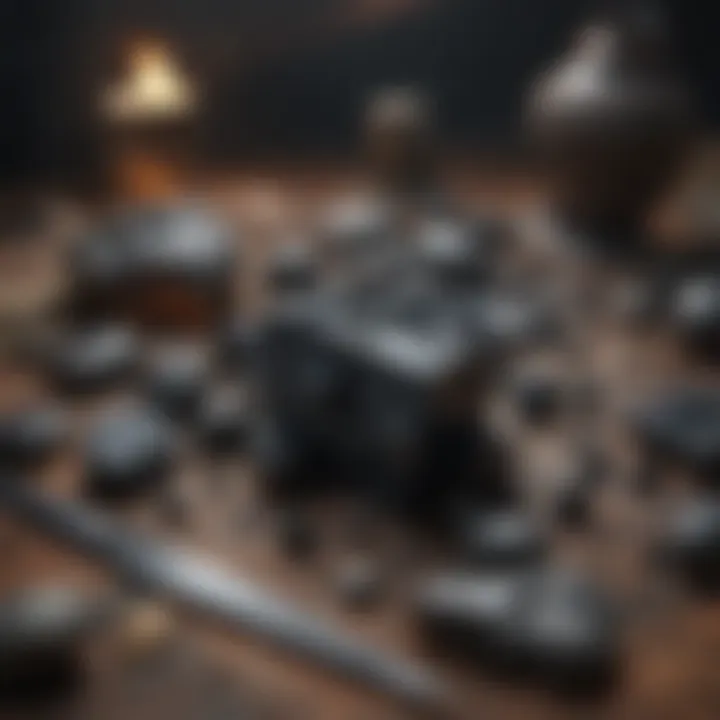Obsidian Identification: A Comprehensive Guide


Key Concepts and Terminology
Definition of Key Terms
Obsidian is a naturally occurring volcanic glass formed when lava cools rapidly. Its formation results in a glassy texture that can be manipulated for various purposes. Understanding obsidian involves knowing key terms such as:
- Igneous Rock: Type of rock formed through the cooling and solidification of magma or lava.
- Volcanic Glass: A common term for glassy rock produced by rapid cooling of molten rock.
- Conchoidal Fracture: A type of fracture that results in a smooth, curved surface, commonly seen in obsidian.
Concepts Explored in the Article
The article will address several fundamental concepts:
- Geological Formation: The processes involved in the formation of obsidian, including volcanic activity and cooling rates.
- Physical Properties: Characteristics such as color, translucency, hardness, and texture that aid in the identification of obsidian.
- Cultural Significance: The historical importance of obsidian in various cultures, including its use in tools and trade.
- Identification Methods: Techniques employed by professionals and enthusiasts to study and classify obsidian.
Findings and Discussion
Main Findings
Through a thorough examination of obsidian, several key findings emerge:
- Obsidian exhibits a variety of colors depending on its mineral content, including black, brown, and even green.
- The unique properties of obsidian, such as its sharp edges when fractured, have made it invaluable in both historical and modern contexts for construction and tool-making.
- Identification often relies on physical characteristics and examination techniques, including visual inspection and the use of different tools.
"Understanding obsidian is not just about its physical characteristics but also its rich cultural narrative."
Potential Areas for Future Research
There are numerous avenues for further exploration in the study of obsidian:
- Technological Advancements: Investigating new methods for testing and characterizing obsidian samples.
- Impact of Climate Change: Examining how changes in the environment may affect volcanic activity and therefore the future availability of obsidian.
- Archaeological Developments: Continued efforts to uncover historical uses and trade routes involving obsidian in ancient cultures.
The blend of geological study with cultural insights provides a multifaceted view of this intriguing material. Understanding obsidian not only contributes to academic disciplines such as geology and anthropology but also enhances appreciation for the materials used in daily life and history.
Prelude to Obsidian
Obsidian is not just an attractive natural glass; it plays a significant role in various fields, from geology to archaeology. Understanding obsidian’s properties and formation provides insights into broader geological processes and human history. This section lays the groundwork for comprehending the rest of the article by detailing the essential characteristics and geological contexts of obsidian.
Definition and Properties
Obsidian is a naturally occurring volcanic glass formed when lava cools rapidly. This rapid cooling prevents crystal formation, resulting in a glassy texture. The main components of obsidian are silica, magnesium oxide, and iron oxide. These contribute to its unique features. Obsidian typically appears black, but it can take on a variety of colors such as green, brown, and even red, depending on its chemical composition and impurities.
The physical properties of obsidian are noteworthy. It has a hardness of 5 to 5.5 on the Mohs scale, making it relatively brittle but capable of being finely sharpened. The glassy surface can produce sharp edges, which historically made it a favored material for tools and weapons. The luster of obsidian is vitreous, giving it a shiny, reflective appearance, and its fracture patterns are conchoidal, which is significant for both practical uses and aesthetic appreciation.
Geological Context
Obsidian is primarily associated with volcanic regions. It forms in subduction zones where the availability of water vapor and gases in molten rock leads to explosive eruptions. These eruptions expel lava that cools quickly, resulting in the glassy substance we know as obsidian. Major geological settings for obsidian formation include continental rift zones, where stretches of the Earth’s crust are pulled apart, and hotspots, where magma rises through the Earth's crust independently of tectonic plate boundaries.
Worldwide, significant deposits of obsidian have been located in places such as the Americas, particularly in Mexico and the United States, as well as Iceland and parts of East Africa. Each region offers obsidian with varying features due to the unique geological processes at play. Understanding these contexts is crucial for those engaged in geological exploration and archaeological investigations, highlighting the interconnectedness of obsidian in both natural and human histories.
The Formation of Obsidian
The formation of obsidian is a critical aspect in understanding this unique volcanic glass. It reveals not only how obsidian is formed but also why it possesses certain properties that make it valuable for study and application. The mechanisms behind its creation highlight the interplay between geological processes and the conditions required for its distinctive nature. Analyzing the factors involved in obsidian formation aids researchers and enthusiasts alike in identifying and utilizing this material effectively.
Volcanic Activity
Obsidian originates from the cooling of molten rock, known as magma, during volcanic eruptions. When magma escapes from the earth's crust and reaches the surface, it can undergo rapid cooling, leading to the formation of this distinctive glassy substance. The key factor here is the high silica content typically found in the magma that creates obsidian. As the molten rock flows and spreads out, various environmental conditions influence the cooling speed.
One crucial element is how quickly the lava is exposed to the air or water. Rapid cooling typically results in a more uniform structure, while slower cooling can lead to the development of more glass-like features. Areas around volcanic regions, such as the Pacific Ring of Fire, are known for their abundance of obsidian deposits due to the frequent volcanic activity in these locales.
"Obsidian is a volcanic glass that forms when lava cools quickly, preventing the formation of crystals."
Understanding volcanic activity is key for geologists and archaeologists who wish to locate and study obsidian. Those who work with obsidian in practical applications, such as tool-making or jewelry design, benefit from knowledge about the type and characteristics of obsidian that can be obtained from different volcanic eruptions.
Cooling Rates
Cooling rates are integral to the formation of obsidian. The way in which lava cools directly affects the physical properties of the resulting obsidian. When magma loses heat rapidly, it doesn't allow for crystal structures to form, resulting in the amorphous nature of obsidian. This property is what distinguishes obsidian from other volcanic rocks, like granite, which undergoes slower cooling and forms visible crystals.
In studying obsidian, researchers examine its cooling rates to draw conclusions about its formation environment. For example, obsidian that forms in volcanic domes typically cools more slowly than obsidian from lava flows. Additionally, the presence of water can significantly increase cooling rates. Water can absorb heat away from the lava more effectively, leading to the rapid formation of obsidian.
Understanding these cooling processes also allows gemologists to identify and categorize different types of obsidian. Factors such as hue and texture are impacted by how quickly the lava cooled and the conditions during its solidification.
In summary, both volcanic activity and cooling rates play pivotal roles in how obsidian is formed, thus contributing to its unique characteristics. This foundational knowledge fosters a deeper appreciation of obsidian, as well as its significance in various applications across science and culture.


Physical Characteristics of Obsidian
Understanding the physical characteristics of obsidian is essential for accurate identification and appreciation of this unique volcanic glass. Its properties not only reveal its geological history but also offer insights into its potential uses across various fields. Analyzing these characteristics aids researchers, gemologists, and enthusiasts in distinguishing obsidian from other similar materials, ensuring that one can correctly classify and utilize it.
Color Variations
Obsidian exhibits a broad spectrum of colors due to its mineral composition and the presence of various inclusions. The most common color of obsidian is black, but it can range from dark brown to green, red, or even clear varieties. This diversity stems from factors such as the cooling conditions and the geographical origin. For instance, mahogany obsidian has rusty red and brown tones due to iron inclusions.
- Common Variants:
- Black Obsidian: Standard form with a high gloss.
- Snowflake Obsidian: Features white crystal patterns.
- Rainbow Obsidian: Displays iridescent colors under different lighting.
These variations serve not only aesthetic purposes but they also can hint at the volcanic conditions under which the obsidian was formed. The color is a key identifier that can assist gemologists in sorting and classifying the material.
Texture and Luster
The texture and luster of obsidian are vital physical traits that can significantly contribute to its identification. Obsidian is known for its glassy texture, providing a smooth surface that is often polished to enhance its appearance. Its luster ranges from a vitreous to a shiny, almost reflective surface. This glass-like quality is a direct result of its amorphous structure, unlike crystalline minerals.
- Vitreous Luster: A hallmark of high-quality obsidian, emphasizing its appeal in jewelry and decoration.
- Surface Texture: The smoothness is often contrasted with inclusions, which may create interesting surface patterns.
Furthermore, how light interacts with obsidian can reveal various features, particularly in jewelry making. The presence of bubbles or other inclusions may give hints about its origin and processing methods. A close examination of texture and luster can often be decisive in distinguishing obsidian from other rock types.
Fracture Patterns
Fracture patterns serve as yet another critical physical characteristic of obsidian. Unlike most minerals that have defined cleavage planes, obsidian displays a conchoidal fracture, which means it breaks along smooth, curved surfaces. This is caused by the way glass breaks under stress.
This fracture pattern is particularly useful for identifying obsidian because it is distinctive and not easily confused with other materials. Some key aspects of fracture patterns include:
- Sharp Edges: The fractures produce sharp edges, making obsidian historically valuable for tool-making.
- Conchoidal Shapes: These shapes can be recognized easily, as they differ from rougher break patterns found in other stones like granite.
Understanding these physical characteristics is valuable for various fields including geology, archaeology, and gemology. Identification of obsidian, through its color, texture, and fracture, is foundational for proper classification and usage.
"The distinct properties of obsidian offer insights into both its past and its potential future applications."
In summary, the study of obsidian's physical characteristics enhances understanding and appreciation, ensuring this natural wonder is recognized for its scientific and practical significance.
Methods for Identifying Obsidian
Identifying obsidian requires an understanding of its unique characteristics and examination techniques. The processes involved in identification can make a significant impact on various fields, including geology, archaeology, and gemology. By employing the right methods, one can determine the authenticity and origin of the obsidian. This helps in distinguishing obsidian from other volcanic glass types, which could appear similar but differ in composition and behavior. Therefore, knowledge of identification methods is essential for accurate analysis.
Visual Inspection
Visual inspection is the first step in identifying obsidian. This method relies on the visual characteristics of the material. Obsidian typically exhibits a glassy luster and varies in color, ranging from black to shades of green, brown, and reddish hues. Some specimens may also contain gas bubbles or mineral inclusions. Importantly, the transparency of obsidian is another distinguishing feature. While it is generally opaque, light can pass through very thin edges, differentiating it from other rocks.
Physical Tests
Hardness Test
The hardness test revolves around measuring a material's resistance to scratching, using the Mohs scale. Obsidian ranks around 5.5 to 6 on this scale, indicating it is relatively hard. The hardness test is beneficial for identifying obsidian because it can quickly rule out materials that are softer or harder. As a popular choice in field identification, it requires minimal equipment, making it accessible for many. However, it does have limitations. Some rocks with similar hardness may confuse the results. Therefore, single hardness testing should not be solely relied upon, as additional methods may be necessary.
Density Measurement
Density measurement evaluates how much mass an object has per unit volume. Obsidian usually has a density range of about 2.3 to 2.5 g/cm³, which can be useful in identification. This method stands out because it offers a quantitative measure that is difficult to manipulate or misinterpret. However, measuring density can be more cumbersome compared to visual tests. The equipment required for accurate density measurement, like a scale and water displacement setup, may not always be available in the field. Hence, while informative, it is often used in conjunction with other tests for more reliable results.
Chemical Analysis
Spectroscopy
Spectroscopy is a powerful tool for identifying obsidian through its chemical composition. This technique involves analyzing the light spectrum emitted or absorbed by the sample. For obsidian, this method reveals unique signatures in the spectrum that correspond to specific chemical elements. It is widely regarded as a precise choice for those looking to verify obsidian's identity. The unique features of spectroscopy allow for non-destructive testing, preserving the integrity of the specimen. However, the high cost and technical expertise required can limit its accessibility in some situations.
X-ray Fluorescence
X-ray fluorescence (XRF) is another advanced method utilized in chemical analysis. This technique uses X-rays to excite the atoms in the sample, prompting them to emit fluorescent X-rays. Those emissions are then analyzed to determine elemental composition. XRF is beneficial due to its efficiency in providing rapid and accurate results without damaging the specimen. It can handle a wide range of materials and is particularly useful in distinguishing between similar volcanic glass types. Nonetheless, the high expense of XRF equipment can be a barrier for independent researchers or smaller organizations.


Both spectroscopy and X-ray fluorescence provide insights into obsidian composition, leading to greater understanding of source and formation.
Cultural and Historical Significance of Obsidian
Obsidian holds a prominent place in both cultural and historical contexts. This volcanic glass was not only appreciated for its aesthetic qualities but also valued for its practical applications. Understanding its significance sheds light on human innovation and cultural evolution throughout history.
Use in Tools
The sharpness and quality of obsidian make it an ideal material for crafting tools. Early humans utilized this material to create cutting instruments and weapons. For instance, obsidian blades can be sharper than steel, making them extremely effective for hunting and butchering. These tools were vital for survival, allowing for more efficient processing of food, which could lead to better nutrition and growth of early societies.
Many archaeological sites have yielded obsidian artifacts, showcasing its widespread use. Cultures in regions such as Mesoamerica and the Pacific Islands frequently crafted tools from obsidian, underlining the material’s global significance. Trade routes often revolved around obsidian deposits, connecting distant communities.
"Obsidian tools have been found in diverse locations, illustrating its importance in trade and technology across cultures."
Today, obsidian is still utilized in various fields. For example, in the medical industry, microblade technology is developed from obsidian for precision surgical tools. This evidences the material's enduring utility, bridging ancient practices to modern applications.
Symbolism in Ancient Civilizations
Beyond tools, obsidian has also held symbolic value across ancient societies. For many cultures, it was associated with the earth's power, protection, and spiritual significance. In Mesoamerican civilizations, such as the Aztecs and Mayans, obsidian was thought to have mystical qualities. Objects crafted from obsidian were often part of religious rituals and offerings, believed to serve as a conduit between the material and spiritual worlds.
The reflective surface of obsidian has led to its comparison with insight and divination. In some traditions, polished obsidian mirrors were utilized for gazing into the future or communicating with ancestors, showcasing its importance beyond mere physical use.
In summary, the cultural and historical significance of obsidian is multi-dimensional. Its utility in tool-making underscores human adaptability, while its symbolism in ancient civilizations reflects the deeper connection between material and belief systems. As we continue to explore obsidian, we can appreciate not only its functional applications but also its role in shaping human culture.
Applications of Obsidian in Modern Society
Obsidian has a wide range of applications in modern society that highlight its versatility and importance. This section focuses on how obsidian is utilized in technology, jewelry, and home decor, showcasing its unique qualities and the reasons behind its continued relevance.
In Technology
Microblade Production
Microblades are thin, sharp pieces of obsidian that are used primarily in cutting tools. One significant aspect of microblade production is the efficiency and effectiveness of obsidian as a cutting material. Obsidian can be fractured to produce edges that are sharper than steel, making it a popular choice for various applications in both ancient and modern contexts.
The key characteristic of microblades is their sharpness, which is crucial for precision tasks. This quality makes them a beneficial option in various industries, including archaeology, where recreating ancient stone tools is essential for understanding human history. Moreover, their lightweight nature adds to their appeal.
A unique feature of microblades is their production technique, which involves knappng—striking the obsidian to create an edge. This technique allows for a controlled production of blades with specific dimensions. The advantages include cost-effectiveness and the ability to produce blades quickly in bulk. However, there are also disadvantages, such as the fragility of obsidian compared to tougher synthetic materials.
Surgical Tools
Obsidian has found a valuable place in the medical field, particularly in the production of surgical tools. One specific aspect is the use of obsidian scalpels, which are known for their incredibly sharp edges. This attribute contributes significantly to minimizing tissue damage during surgeries, facilitating faster healing processes for patients.
The key characteristic of surgical tools made from obsidian is their precision. These tools can create clean incisions, which are paramount in delicate surgical procedures. Hence, they are a beneficial choice for operations requiring high levels of accuracy, such as eye surgeries or neurosurgery.
The unique feature of obsidian surgical tools is the quality of the blades. They deliver scalpel-like sharpness that is rarely found in traditional metal instruments. The advantages include reduced risk of infection due to cleaner cuts, while the disadvantages primarily include the need for careful handling due to the brittleness of the material.
In Jewelry and Decor
Obsidian is also widely recognized for its aesthetic appeal in jewelry and home decor. The rich colors and natural patterns of obsidian stones make them desirable choices in crafting beautiful accessories.
Jewelry made from obsidian showcases its beauty through various forms, such as necklaces, bracelets, and earrings. The polished surface of obsidian creates a striking contrast with other materials, adding elegance and a hint of sophistication to any outfit.
In home decor, obsidian is often used in the creation of decorative objects, including sculptures, bowls, and tiles. The allure of obsidian in decor lies in its natural beauty and the unique variations in color and texture, which can complement various design styles.
Additionally, obsidian is often linked to various cultural significances, making it a thoughtful gift in many contexts. This connection to tradition can make pieces more meaningful for those who own them.
"Obsidian's blend of beauty and utility establishes it as a remarkable material in both technology and culture."
In summary, obsidian continues to maintain its significance in modern society through its applications in technology and decorative arts. From the precision of microblades and surgical tools to the beauty of jewelry and home decor, obsidian is more than just a geological formation; it is a crucial element that merges form and function.
Geographical Distribution of Obsidian
Understanding the geographical distribution of obsidian is essential for both identification and application. This natural glass is found in specific regions formed by ancient volcanic activity, making its occurrence relatively selective. Knowledge of where obsidian deposits are located helps geologists, archaeologists, and gemologists alike in their studies, whether they are looking for historical artifacts or assessing rock characteristics for modern use.


Obsidian is not just a geological curiosity; it plays a crucial role in various fields of research, including environmental science. Knowing the locations can assist in evaluating the ecological impact of mining and resource extraction.
Major Deposits Worldwide
Obsidian deposits can be found on every continent except for Australia and Antarctica. Major locations include:
- Iceland: Notable for its striking black obsidian, often used in tools and art.
- Mexico: Known for a variety called Apache tear, which is a translucent black obsidian.
- United States: High-quality obsidian can be found in California and Oregon, prized for its sharp edges and glassy appearance.
- Japan: Features unique forms of obsidian that have cultural significance.
These major deposits are significant because the properties of obsidian can vary greatly depending on their geological settings. The local geology affects the color, clarity, and texture of obsidian, which in turn influences its desirability and uses.
Local Variations and Unique Forms
Local variations in obsidian arise not only from the volcanic activity that produces them but also from the minerals in the surrounding environment. These variations can lead to unique forms such as:
- Banding: Some obsidians show layered colors due to the blending of different lava sources.
- Snowflake Obsidian: Embedded with white crystals, this type forms when gas bubbles get trapped during cooling.
- Rainbow Obsidian: Characterized by iridescent colors, this version is often a sought-after choice for jewelry and decoration.
Understanding these local variations is paramount when identifying obsidian. Each variety may appeal to different markets, from scientific studies to artistic applications. By familiarizing oneself with these characteristics, one improves the accuracy of identification and can appreciate the diversity that obsidian offers.
"The geographical distribution of obsidian is not merely an academic interest; it informs practical applications across various disciplines."
In summary, the study of obsidian’s geographical distribution enhances the understanding of its properties and cultural significance, leading to better resource management and informed identification practices.
Environmental and Ethical Considerations
The topic of environmental and ethical considerations plays a vital role in the discourse on obsidian. As the demand for natural materials rises, it becomes essential to reflect on how the sourcing and utilization of obsidian affects both the environment and local communities. Increasing awareness of sustainability has incentivized researchers, manufacturers, and consumers to examine not just the properties of obsidian, but also the broader implications of its extraction and use.
With the growing market for obsidian products, understanding the implications of mining practices and their effects on ecosystems is necessary for responsible stewardship of this resource. Sustainable sourcing ensures that obsidian is acquired in ways that protect the integrity of geological deposits and the well-being of surrounding areas. Moreover, ethical considerations regarding labor practices in the mining sector must not be overlooked. As a result, it is critical that all stakeholders engage in conscious efforts to secure materials responsibly.
Sustainable Sourcing
Sustainable sourcing of obsidian refers to methods of extraction that prioritize environmental health and community welfare. This involves minimizing the ecological footprint of mining practices, ensuring that local wildlife and habitats are protected. Techniques such as precision mining can reduce waste and limit the area affected by excavation. Implementing regulations on the quantity of obsidian that can be harvested helps to prevent over-extraction, thus extending the lifespan of deposits and maintaining the ecosystem.
Additionally, collaborating with local communities during mining operations fosters better relationships and offers economic benefits. When communities have a stake in sustainable practices, they are more likely to engage in protective measures for both their environment and culture. Furthermore, sustainable sourcing can enhance the market value of obsidian products, as consumers increasingly seek materials that are harvested ethically.
- Benefits of sustainable sourcing include:
- Preservation of local ecosystems
- Economic empowerment of local communities
- Long-term availability of obsidian resources
"Sustainable sourcing not only safeguards environments but also strengthens community ties, fostering mutual respect among stakeholders."
Impact on Local Ecosystems
The mining and extraction of obsidian can have significant impacts on local ecosystems. Disruption of the land during mining activities may lead to erosion, disruption of flora and fauna, and depletion of local water resources. Identifying areas rich in obsidian without causing extensive environmental damage is a challenge that the industry faces. For this reason, comprehensive environmental assessments are crucial before any mining operation begins.
Moreover, the disturbance of habitats may yield changes in species composition and biodiversity. These implications make it vital to integrate environmental science into the planning and management of obsidian mining to monitor ecosystem health.
To mitigate adverse impacts, the following strategies can be implemented:
- Conducting thorough environmental impact assessments
- Restoring mined areas post-extraction
- Implementing biodiversity preservation programs
In summary, the focus on environmental and ethical considerations in the context of obsidian underscores the necessity for responsible practices in sourcing and utilizing this unique igneous rock. By prioritizing sustainability and the well-being of local ecosystems and communities, we can ensure that obsidian remains a valuable resource for future generations.
Research and Future Directions
Research into obsidian continues to offer valuable insights into its properties and potential uses. The study of this naturally occurring volcanic glass spans several disciplines, including geology, archaeology, and materials science. This section will explore the current trends in obsidian research and anticipate future applications that may benefit from its unique characteristics.
Current Research Trends
In recent years, there has been a notable increase in studies focused on the characterization of obsidian. Researchers are utilizing advanced techniques such as electron microscopy and chemical stratigraphy to analyze obsidian artifacts. These methods help in understanding the material’s provenance and its ancient trade routes, which are crucial for archaeological purposes. Additionally, studies are looking into the microstructural properties of obsidian to better comprehend its durability and workability in toolmaking.
The interest in obsidian as a geological indicator is also growing. Increased volcanic activity in specific regions prompts geologists to investigate the presence and composition of obsidian deposits. These studies contribute not only to geological mapping but also to understanding the historical activity of volcanoes.
Future Applications in Science and Technology
Looking toward the future, the applications of obsidian are promising. In the field of materials science, obsidian's sharp edges and high durability make it a candidate for high-performance cutting tools. Researchers are exploring the use of obsidian in manufacturing advancements such as microblades for various industries, including surgery.
Moreover, the potential of obsidian in the development of bioactive glass is under investigation. This type of material could lead to innovations in medical implants and other health-related technologies.
Furthermore, with the rise of sustainable sourcing practices, obsidian may see a resurgence in the jewelry and decorative markets. Its natural beauty and uniqueness lend themselves to high demand among consumers focused on ethical sourcing.
The exploration of obsidian will continue to evolve, merging ancient uses with modern technology to create novel applications.







